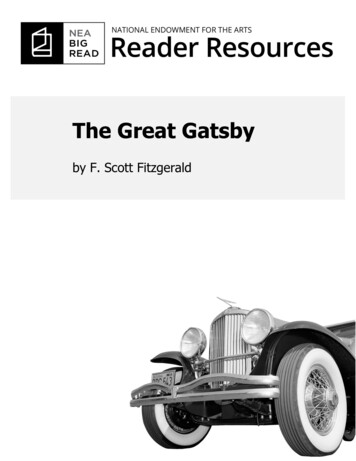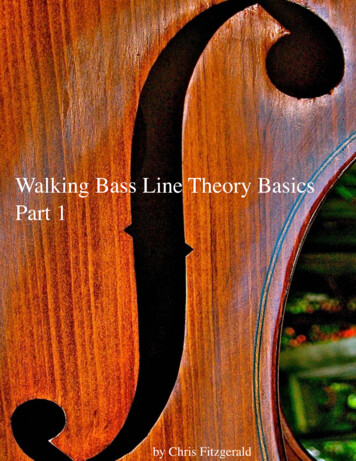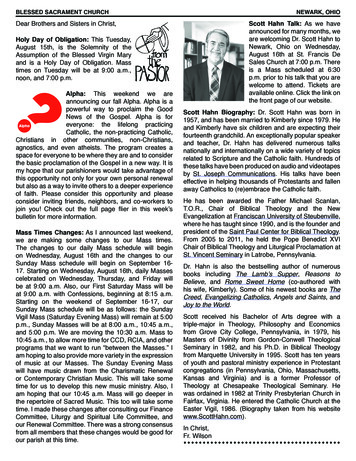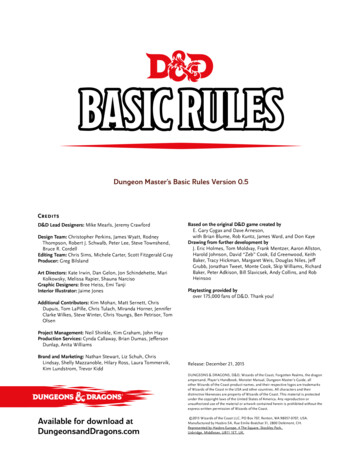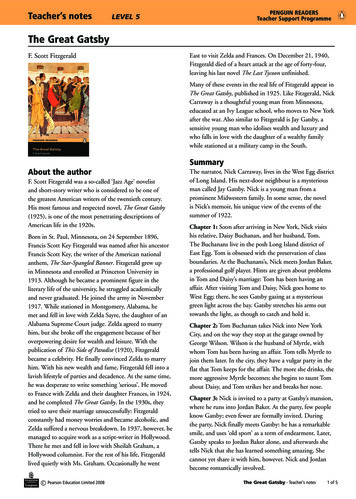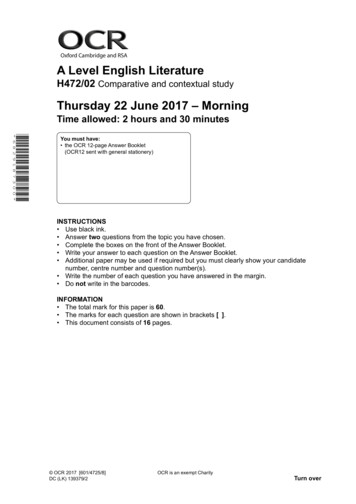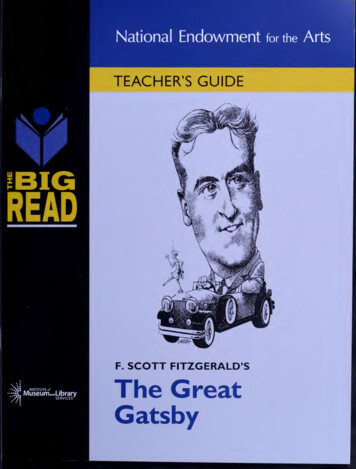
Transcription
NationalEndowmentTEACHER'S GUIDEF. MuseurriandLibrarySERVICESSCOTT FITZGERALD'SThe GreatGatsbyfor theArts
NATIONALENDOWMENTFOR THE ARTSUJyREADF.SCOTT FITZGERALD'SThe GreatGatsbyTEACHER'S GUIDE
TheEndowmentNationalexcellence in the artsNATIONALand providing— both new andisa public agency dedicated to supportingestablished—independent agency of the federal government, theFOR THE ARTSannual hinder of thegreat nationdeserves great art.and ing great art toallby CongressEndowment50isinallAmericans,1965 as anthe nation's largestincluding rural areas, innerstates,bases.122,000strong libraries andworksarts,of Museum and Library Servicesfor the nations ;! .institutedbringing the arts toleadership in arts education. EstablishedENDOWMENTA:v.for the Artslibrariesmuseumsat the national levelisthe primary source of federal supportand 17,500 museums. TheInstitute'sthat connect people to informationandin coordinationwithstateandandmissionideas.isto createTheInstitutelocal organizations toand knowledge; enhance learning and innovation; and supportsustain heritage, culture,professional development.Arts Midwest connects people throughout the Midwest and the world to meaningful artsASMIDWESTopportunities, sharing creativity, knowledge,inand understandingacross boundaries.BasedMinneapolis, Arts Midwest connects the arts to audiences throughout the nine-stateregion ofIllinois,Dakota, and Wisconsin.States,North Dakota, Ohio, SouthIndiana, Iowa, Michigan, Minnesota,Oneof six non-profit regionalarts organizations in theUnitedArts Midwest's history spans more than 25 years.Additional support forTheBig Read has also been provided by theW.K. KelloggFoundation.Published byNational1Endowmentfor the Arts100 Pennsylvania Avenue, N.W.Washington,DC 20506-0001(202) 682-5400www.nea.govSourcesExcerpts reprinted with permission of Scribner, an imprint of Simonfrom The Great Gatsby byF.Scott Fitzgerald, & Schuster Adult Publishing Group,1925 by Charles Scribner's Sons. Copyright renewed 1953by Frances Scott Fitzgerald Lanahan.AcknowledgmentsDavid Kipen,NEADirector of Literature, National Reading InitiativesSarah Bainter Cunningham, PhD,Writer: Sarah BainterSeries Editor:NEA Director of Arts EducationCunninghamMolly Thomas-Hicksfor thefor theNationalEndowmentNationalEndowmentGraphic Design: Fletcher Design/Washington,for the Arts,with a preface byDanaCioiafor the ArtsDCImage CreditsCoverPortrait:John SherffiusforThe Big Read. PageFrancis Cugat, used courtesy of Scribner, an imprint ofFitzgerald,cover:F.American Stock/Getty Images; Page1:iv:The Great Gatsby book cover, cover painting bySimon& Schuster Adult Publishing Group;Caricature ofDanaF.ScottGioia by John Sherffius. Inside backScott Fitzgerald, Getty Images.July2008
Table of ContentsIntroduction1Suggested Teaching Schedule2Lesson One: Biography4Lesson Two: Culture and History5Lesson Three: Narrative and Point of View6Lesson Four: Characters7Lesson Five: Figurative Language8LessonSix:Symbols9Lesson Seven: Character DevelopmentLesson Eight:TheLesson Nine:Themes of the NovelLesson Ten:Plot UnfoldsWhat Makesa1011Book12Great?13Essay Topics14Capstone Projects15Handout One:Prohibition16Handout Two:Gatsby'sGuideHandout Three: HarlemtoManhoodin the JazzAge1718Teaching Resources19NCTE Standards20
cotfan unbroken series ofsuccessful gestures, then there wassomething gorgeous about him, someheightened sensitivity to the promisesof life, as if he were related to one ofthose intricate machines that registerearthquakes ten thousand miles away.This responsiveness had nothing to dowith that flabby impressionability whichis dignified under the name of 'creativetemperament' it was an extraordinarygift for hope, a romantic readiness suchas have never found in any otherperson and which it is not likely should"If personalityis—IIever find again."—F.SCOTT FITZGERALDfrom The Great GatsbyIV*THEBIGREADJanonai*v.'jiiraiTft)
IntroductionWelcome to The Big Read, a major initiative from the NationalEndowment for the Arts designed to revitalize the role of literaryinAmericanculture.TheBigreadingRead hopes to unite communities throughbecomegreat literature, as well as inspire students tolife-long readers.This Big Read Teacher's Guide contains ten lessons to lead you throughF.Scott Fitzgerald's classic novel, The Great Gatsby. Each lesson has foursections: a thematic focus, discussion activities, writing exercises, andhomeworkassignments.Inaddition,wehave provided suggested essaytopics and capstone projects, as well as handouts withmore backgroundinformation about the novel, the historical period, and the author. Alllessons dovetail with the state language arts standards requiredinthefiction genre.TheBigRead teaching materials also includeaCD. Packed withcommentaries, and excerpts from the novel, The Big Readfirst-hand accounts ofdecades afterits initialwhyFitzgerald's novelpublication.SomeCDof America'smost celebratedmakeBigReadexciting additions to the classroom.Finally,TheBigRead Reader's Guide deepens your exploration withinterviews, booklists, time lines, and historical information.thispresentsremains so compelling eightwriters, scholars, and actors have volunteered their time toCDsinterviews,Wehopeguide and syllabus allow you to have fun with your students whileintroducingthem to the workof a great American author.From the NEA, we wish you an ju&excitingand productive schoolyear.H &\tDana GioiaChairman, National Endowment for the ArtsNationalEndowmentfor the ArtsTHE BIG READ
-5ThreeDay- :r1.r:-BK 1Z -Trad 3ne Rebc RmmAeS-isay*.-.''. ia* z:Amvniei Exr: thE szd- -a--ai ::":-.a- aiian.is the::fira4Day TwoFourPOQvines lists' EC-.::-nca11antagDnsi Examrne miner r .a-a e-: »*hc:-ndoiitOne *e*rz1.-fe cfauta*j MJn ii jiiiff-3813DayFive-11-'.- 7- -.---evte* the nove. roe :-so a no-* jsn-1-2 --.--.:iques c4::—
6Day9Day NineSixFOCUS: ThemesFOCUS: SymbolsActivities:Discuss the symbolsinthe novel.Have students proposethemes to examine moreWrite about the "American Dream."Homework: ChapterActivities:interpretation based6 (pp. 97-111).Homework:closely.potentialDevelop anon one of the themes.Begin essays. Complete outlinesfor next class.7Day Seven10FOCUS: Character DevelopmentDay TenActivities:Explorehowcharacters changewithin the story. Examinewhether thelandscape reflects point of view.CopyHandout Two. Write about the novelHomework: Chapter 7FOCUS: What MakesActivities:as acoming-of-age story.successful.makeFitzgerald's novelPeer review paper outlinesdrafts.Homework:8Book Great?Explore the qualities of a greatthe qualities that(pp. 113-145).anovel and a voice of a generation. ExamineandDayof the NovelEssay due during the nextclass period.EightFOCUS: TheActivities:Plot UnfoldsChart a timeline of thestory.Develop a plot for the sequel.Homework: Chapters 8 and 9(pp. 147-180).NationalEndowmentfor the ArtsTHEBIGREAD 3
Examining an authorscan inform and expand thelifeunderstanding of a novel. Biographical criticismwork through thea literaryexplore the authorslifetounderstand the novel morehe was from British royaltyFOCUS:BiographyA weak student,doorstep.parentshopedwaswould improvethat this educationPaul,Minnesota, toinspireliked to imaginehis parents'sent to boarding school. Hischaracters in the novel, Fitzgerald took a trainSt.New York adventuresandlives.Fitzgeraldthis lesson,fully.As a child, Fitzgeraldand had been abandoned onNicks and Gatsbysevents inthe practice of analyzingisof an authors experience. InlensScott Fitzgerald's Minnesota childhoodF.reader'shis prospects. Like thefromNew York City. Many of histhe effects that a physical departure from theMidwest homehisinshort stories exploreMidwest could have onaperson.Discussion ActivitiesListen toTheBigAsk students toCopyRead CD, Track One. Students should take notes as theydiscusswhat they learned aboutReader's Guide essays,listen.Scott Fitzgerald from theF.CD.Scott Fitzgerald" (pp. 6-7), "Fitzgerald and"F.the Jazz Age" (pp. 8-9), and "Fitzgerald and His OtherWorks"(pp. 10-11).Divide the class into groups. Assign one essay to each group. After reading andgroupdiscussing the essays, eachwillstudents to add a creative twist topresent whatmakeitlearned from the essay.their presentationsAskmemorable.Writing ExerciseThenovel begins with a quote fromFitzgerald's This Side of Paradise:Ifyou can bouncebouncinglover,/1high,Hnightmust have you!" What doesand aTHE BIG READthis epigraph.ifthat willmoveher;/she cry "Lover, gold-hatted, high-thispoem mean? Askstudents toBased on what they learned from thethink Fitzgerald chose this quote?inI(pp. 1-21).order to completeconsider these questions:*Tillhat,character fromHomeworkRead Chapter4D'lnvilliers, a"Then wear the goldbounce for her too,/examine the intention behindCD, why do theyThomas ParkeNationallittlePrepare your students to read roughly 20 pages perthisWhybookisinNickten lessons.telling thisdisgusted" at the end of the chapter?Endowmentfor the ArtsAs theystory?read, students shouldWhyisNick "confused
(ulturalandhistorical contexts give birth to thedilemmas and themesand appreciatingthe center of the novel. Studying these contextsatintricatetime and place help readers understand the motivations ofdetails or thethe characters.The Great Gatsbyabroad.itsFOCUS:set in theThe Unitedmid- 1920s, a prosperous timehad joined WorldStatesWarIhome andatin 1917, three years aftereruption. The 1919 Peace of Paris established accord between nationsManyended the war.thatconsidered American intervention the bestand quick Alliedto a decisiveCulture andHistoryisProhibition athomeled to awayvictory.growing world of organized crime,as the saleof alcohol went underground. Even the 1919 World Series was affected,members of the White Soxtheseries,(theteam favoredasto win) decided to "throw"creating larger profits for those gambling against the Sox. InHarlem, the northern migration of African Americans created anexpansion of literature, music, plays,political tracts,andartisticAndvisual art.around the country, technology produced new opportunitiesforAmericans,including radio, motion pictures, automobiles, and electric appliances.Discussion ActivitiesListen toTheRead CD, Track Two. Maureen Corrigan explains thatBigin thisAsk students the following questions: Fromwhat you heard on the CD, what do you think Corrigan means? Is there anynovel,"youcan't get at the truth."indication, in the firsttwenty-one pages, thatGoto NEA's JazzintheWebclicksiteandthe SchoolsWebon the "Listen"site,firstrecordedHowand "West End Blues."Before you answer,spiritsolo.listenwillnot "get at the truth"?www.neajazzintheschools.org. EnterHere you will find samples of"Chimes Blues," which includes Louisheading.legendary jazz recordings. Play King Oliver'sArmstrong'sweMove onto Armstrong's "Sugar Foot Stomp"does Armstrong's music change from 1923 to 1928?to each piece again.Howdoesthismusic capture theof the 1920s?Writing ExerciseHave students read Handouts One and Three. After reading these handouts andlistening toBigReadCDwrite a one-pagesummaryone pages of thenovel,learned?23TheWhy or whyisand/or Louis Armstrong's music, students shouldof the arts and culture of the era.InFitzgerald's depiction consistent withthefirsttwenty-what they havenot?HomeworkHave students read Chapter 2the end of Chapter 2?HowNational(pp.23-38).Whatdoes Nick learn aboutdoes Tom's treatment of Mrs. WilsonEndowmentfor theArtsaffectTHE BIG READ TomNick?5at
Thenarratortellsthe story with a specific perspective informed by his orher beliefs and experiences. Narrators can be major or minor characters,or exist outside the story altogether.of view, including ignorance andThenarrator weaves her or his pointnarrator participates in the events of the novel,narrator, often not a character,andFOCUS:isA first-personusing "I." A distancedbias, into telling the tale.removed from the action of the storyuses the third-person (he, she,andthey).Thedistanced narratormaybe omniscient, able to read the minds of all the characters, or limited,describing only certain characters' thoughtsNarrativeand Point ofandfeelings. Ultimately, thetype of narrator determines the point of view from which the storyThe Great Gatsbytold in the first personisistold.by Nick Carraway. The novelbegins from the point of view of an older Nick, reminiscing on the eventsViewof one summer. Nicks perspective, entangled in the dramatic action,subjectively depicts a series of events.Discussion ActivitiesAsk students to list the things they've learned about Nick Carraway in the firsttwo chapters of the novel. How might his background color the way he tells thisstory?HowHow trustworthyisNick?might the perspective of Chapterto narrate the storyinIchangeif F.Scott Fitzgerald had chosenthe third person from Daisy's "sophisticated" point ofview? Have the class brainstorm the outline ofthisnewchapter.Writing ExerciseBased on the previousactivity,Chapter 2 begins with theEckleburg."What doEJWhat doTHE BIG READand the "eyes of DoctorT.J.they reveal about Nick's character and point of view?Homework3 (pp. 39-59).observations before*"valley of ashes"they reveal about the landscape?Read Chapter6write a few pages of Daisy's version of the story.NationalEndowmentwe meetfor the ArtsWhat do wehim?learnabout Gatsby from Nick's
Theworkcentral character in aThe protagonist usuallyovercomesof literatureinitiates thea flaw, such asmainiscalled the protagonist.action of the storyand oftenweakness or ignorance, to achieve a newunderstanding by the works end.Aprotagonisthonor or courage may be called a hero.Anwhoantiheroactsiswith greata protagonistlacking these qualities. Instead of being dignified, brave, idealistic, orpurposeful, the antiheroThewhoFOCUS:Charactersmay beprotagonists journeyhold differingbeliefs.isenriched by encounters with charactersOnecontrast with the protagonistsmain characterscowardly, self-interested, or weak.such character type, aand highlight importantThe most importantpersonality.foil,foil,hastraits thatfeatures of thethe antagonist,opposes the protagonist, barring or complicating his or her success.Nick Carraway narrates theGatsby s loveprotagonist.Gatsby s questto regainstory,affairbutit iswhoJay Gatsbyisthe novel'swith Daisy, her marriage to Tom, andDaisys affection provide thestory's narrative arc.Discussion ActivitiesAsk your students theWhatfollowing questions:kind of personisNickHow does he compare to narrators in other novels your studentsstudied? How might Nick's narration color the way readers view the otherCarraway?havecharacters?Ishe areliable narrator?two secondary characters: Daisy,Wilson, Mrs. McKee, Catherine, Mr. McKee, or Gatsby'sDivide the class into groups. Assign each groupJordan,Tom,party-goers.each groupMyrtle,Ask students to review thelistkey attributes ofitsfirstthree chapters of the novel. Havecharacters. Prepare a presentation thatdocuments moments when these characters bring out reactions from Nick.What dothese characters teach Nick about himself?What do welearnaboutGatsby?Writing ExerciseHave students write two pages on the character theyto Nick, to Gatsby, or to both men.Whatmake him or her an opposingHowforce?qualitiesbelieve to be an antagonistdoesthischaracter have thatmight encounters with the antagonistchange Nick or Gatsby?EJHomeworkHomework: Chapter 4(pp.61-80). Ask students to consider Fitzgerald'sdescriptions as they read. Find the threeAre theyeffective?Why or whynot?mostWhydoes Nickpursued, the pursuing, the busy, and the tired"NationalEndowmentvivid descriptions in(p.say,Chapter"There are only the79)?for the Arts4.THEBIGREAD 7
W nrers use figurative language such as imagery,—awordadds immediacy to—language.literaryour imaginations, findingfigurative language asks us to stretchthings that initially seem quite different but areisa comparison of twoshownto have significantresemblance. Similes employ connective words, usually "like,"Figurativeor a verb such as "resembles."LanguageA metaphorsomethingelse that, in a literal sense,somethingelse,aandhelps create a physical experience for the readerthe likeness in seemingly unrelated things. SimileFOCUS:in a storv.or phrase that refers to sensorv experience (sight, sound,smell, touch, or taste)Someand metaphorsand experience events and emotionsto help the reader \isualizeImagerysimiles,metaphorit isis"as," "than,"a statement that one thingnot.Byasserting that a thingcreates a close association that underscoresimportant similarity between these twothir.isisanDiscussion ActivitiesDivide the class into groups. Assign each group a chapter (1-4) and askThey shouldusedinthat chapter.images, similes, and metaphors.Inthose chapters,identify figurative languagelanguage assistin tellinghow doesthem tospecifically identifythe figurativethe story? Have groups present their findings to theclass.Writing ExerciseHave studentspick literaryterms out ofa hatand writeasentence that reflectsthe literary technique. Have each student read aloud the sentence he or shewrote. The rest of the class must identify what technique the student wasattempting to master.Have students writechildhood event.metaphorInafew paragraphstelling astory about an importanttheir stories, students should use imagery, simile, andat least twice.Can they see how developingfigurative languageinastory contributes to the artistry of the novel ?EHomeworkRead Chapter 5(pp. 81-96).Students should find examples of one (or two) ofthe literary techniques discussedto begin the next discussion.8 3READNationalEndowmentfor the Artsin class.They should be ready to present them
Symbols arc persons,beyonda literal understanding.symbolsTheof storytelling depends oncraftand point toward new meanings. Mostto present ideasa specific object will be used to refer to (or symbolize) stractrepeated appearance of an object stiggests a non-literal, ormeaning attachedfigurative,have significanceplaces, or tilings in a narrative thatbeginning and end of theat thetitle,action, or in theSymbolsto the object.nameare oftenstory,or personality of a character.foundinwithin a profoundThelifeof a novelisperpetuated by generations of readers interpreting and reinterpreting themain symbols. Byrevealnewidentifyingand understanding symbols,readers caninterpretations of the novel.Discussion ActivitiesDiscuss the valley of ashesChapterincultural contexts of the novel,Discusswhat might theinthe story?someWhat do welearninmind thebuoyed upasinhistoricalvalley symbolize?the story.HowWhyandmightas the pursuit of wealth,about Nick fromof the other potent symbolsinterpretive keys to the novel's meaning?thisKeepingwant to underscore an important theme, suchFitzgeraldso early2.his description?Howare thesemight the "two young women.though upon an anchored balloon"(p.8) symbolize thewomenofgeneration?Gatsby looks for Daisythe story trulyknowinthe greenDaisy?light atDoes thelightthe end of her dock.becomeaDoes anyonesymbol for somethinginelse?Writing ExerciseNick describes that Gatsby had created anillusionof "colossalvitality."three paragraphs from Nick's point of view considering what Daisy hasrepresent.feelE3WhyHowhas Gatsby created such a "colossal" illusion?Writecomedoes Nickabout the elevation of Daisy to almost epic status?HomeworkAt the end of Chapter 5, Nick says, "It was theprofound human change, and excitement was generating on the air"Read Chapter 6hour of a(p.95).What(pp.97-1happensin11).Chapter 6 toNationalfulfillEndowmentNick's prediction?for the ArtsTHEBIGtoREAD 9
whoNovels trace the development of characterschallenges.InternalMostcharacters contain aand externalovercomefears,ofseriescomplex balance of virtues andvices.forces require characters to question themselves,or reconsider dreams.profound change.Lesson Sevenencounter aTheprotagonistmay undergoA close study of character development maps,character, the evolution of motivation, personality,andbelief.in eachThetensionbetween a characters strengths and weaknesses keeps the reader guessingFOCUS:Characterabout what might happen next and the protagonist's eventual successor failure.In The Great Gatsby, Fitzgerald explores characters in relation to theirDevelopmentlandscape, their wealth,andtheir prior relationships.about these characters, the more theirlives shiftThe more we knowfromidyllic islandsofwealth to colorless portraits floating through a "valley of ashes" with"grotesque gardens." In this lesson, examine Fitzgerald's ability to presentcharacters in both their idealandrealcountenances.Discussion ActivitiesAsk students to consider whether any of the main characters have changed inthe novel's first six chapters. Examine Tom, Daisy, Nick, Jordan, and Gatsby.Are there any moments when these characters have a realization about theircircumstances or change a firmly held opinion?Inthe beginning of the novel, Daisy says contemptuously "Sophisticated— God,Now that we knowdid sheI'm sophisticated!" (p. 17).mean? Does herwhyliferepresent the freespiritmore aboutDaisy,whatof the Roaring Twenties?Ifnot,not?Howdoes the way Fitzgerald describes the Longinternal struggles of theIsland landscape parallel themain characters?Writing ExerciseHave students read Handout Two and writeisa coming-of-age story.thisisWhicha brief essaycharacters are growinginon whether or notmaturity and insightI*THE BIG READHomeworkComeRead Chapter 7(pp.turning pointsthe plot of the novel.Nationalifa coming-of-age story? Students should support their conclusions by withquotes from the novel.EJthisEndowmentin113-145).for the Artsto class with thetwo most important
Theauthor craftsand developa plot structure to create expectations, increasecharacters.The pacing of events can makepredictable or riveting. Foreshadowingsuspense,a novel eitherand flashbacks allow the authortodefy the constraints of time. Sometimes an author can confound a simpleplotbypeakof the story's conflictdenouement,FOCUS:Thewithintelling storiesinstories.—which theIn a conventionalthe climax—iswork of fiction, thefollowed by the resolution, oreffects of that climactic action are presented.The Great Gatsby has a remarkable structure. Chapter 5 provides thewhen Gatsby reunites with Daisy, whenNick experiences a grand foreboding, and when Daisy's voice becomesa "deathless song." Some chapters exhibit parallels. Chapters 2 and 8emotional center of the drama:PlotUnfoldsare physically violent turning points, with grotesque landscapes, dust,andashes.Thememories ofnovel begins with Nick's arrival tohis father's words.Nick wants "the worldof moral attention forever'' (p. 2).Gatsby s father and Nick'sof theWestafter all.LongThewewhich made us subtly unadaptabletobeand. athisa sortnovel ends with an encounter withrealization: "I see[PjerhapsIslandnowthat this has been a storysomepossesseddeficiency incommonto Eastern life" (p. 176).Discussion ActivitiesHave studentsidentify themost important turningto identify the passages from the novel, explainingUsesignificant.Mapthisinformation for the nextAsk themwhy these events are the mostpointsinthe novel.activity.a timeline that depicts the dramatic build-upinthe novel. Thismapshouldmost significant turning points but also examine the lesser events thattension. As students develop their maps, they should define the beginning,include thebuildmiddle, and end of the plot.Writing ExerciseOutline a sequel to Fitzgerald's novel.studentsmapHow wouldthis plot unfold?the beginning, middle, and end? HaveHowmightthem write the openingparagraphs to the sequel.Rewrite the novel's ending aspowerful?E3Why or whynot?ifGatsby and Daisy reunite. Would the novel be asWhatmight makethisnewplot successful?HomeworkRead Chapters 8 and 9(pp. 147-180).Why does"high price for living too long with a singleNationalEndowmentNick think that Gatsby paid adream"?for the ArtsTHE BIG READ
Themesare the central, recurring subjects of a novel.with circumstances such as racism,questions will arise in the reader'sandsocietal expectations. ClassicAscharacters grappleor unrequited love, profoundclass,mind about humanthemes includelife,social pressures,freedom versusintellectualcensorship, the relationship between ones personal moral codepolitical justice,andspiritual faith versus rational considerations.often reconsiders these age-old debates by presentingFOCUS:or fromThemesofnewandtheminlargerA novelnewcontextspoints of view.Discussion Activities and Writing Exercisethe NovelDiscuss as a class several of the major themes of the novel using the topics belowAsk students to write a two-page essayon what they consider to be the book's most important theme exploring thereasons the topic would have resonated with readers when the book was firstand those that the studentspublished.the topicIsstillidentify.relevant today?Ifso,why?Ifnot,whynot?AlienationAt one party, Nick observes, "People disappeared, reappeared, made plans to gosomewhere, and then lost each other, searched for each other, found each otherafew feet away"Soon afterward,(p. 37).Tombreakshis lover'snose.Fitzgerald use parties to highlight his characters' failures to relate toDoDoesone another?Gatsby's parties reflect genuine celebration or a kind of mourning?FriendshipNickisWhatthe only person, aside from Gatsby's father,kind of friendshipthis friendship?Is itdo Nick and Gatsby have?who attends the funeral.What does Nick derive fromtrue friendship, or does Nick simply pity l,7,weGatsby has becomethe world ashe disguisedbiography?Dan Cody'shisIsJames Gatz of North Dakota. In theego, leaving James Gatz behind as he travelslearn of Gatsby's origins ashis altersteward.Wasmid-western originsinGatsby doomed to tragedy as long asfavor of amoreextravagant, fictionalNick judging Gatsby for these imaginative exploits or admiringthisskill?The American DreamInan era ofnewFitzgerald's noveltechnology,newopportunity, and artistic expansion, doescomment on AmericanGatsby a satire or critique of AmericanEJmorality and idealism?life? Ifnot,whyIsThe Greatnot?HomeworkBegin essays, using the essay topics at the end of this guide. Outlines are due atthe nextI2*THE BIG READNationalclass.Endowmentfor the Arts
Greatstories articulateand explore the mysteries of our dailylarger context of thehumanlanguage inform theplot, characters,to learn, imagine,manybreaksandstruggle.writers voice, style,theand use ofand themes. By creating opportunitieswork of artreflect, a greatnovelisgenerations of readers, changeslives,challenges assumptions,athat affectsandnew ground.FOCUS:Discussion ActivitiesWhat MakesAsk students to makethe board.a Book Great?Thelives inWhatalistof the characteristics of a great book. Put theseThen ask them to discuss, withinthe same characteristics. Do any ofelevates a novel to greatness?groups, other books that includesomeofthese books remind them of The Great Gatsby!A great writeronIsthis agreat novel?What kind of voice doesWhat does this voice tell uscan be the voice of a generation.Nick and Gatsby?Fitzgerald provide throughaboutthe concerns and dreams of their generation?was the novel of the Lostrepresent the hopes and dreams of Americans duringAccording to avant-garde writer GertrudeGeneration.HowmightitStein, thisthe 1920s?Ifyou were the voice of your generation, what would be your most importantmessage?Whyan essay?Whatmight you choose to conveystory would youtellthis in anovel rather than a speech orto get your point across?Writing ExerciseHave students work ondrafts,23their essaysin class.Beavailable to assist with outlines,and arguments. Have them partner with another student to edit outlinesForand roughdrafts.look fora well-written essay.inthis editing,provide students with alistof things they shouldHomeworkStudents shouldfinish writing theirCelebrate by participatingina Bigessays to handinduring the next class period.Read community event or show afilm versionof The Great Gatsby.NationalEndowmentfor the ArtsTHE BIG READ 3
Theasand writingdiscussion activitiesdo the Discussion Questionsownyou withexercises in this guide providepossible essay topics,Readers Guide. Advanced students can come up with theirin theessay topics, as long as they are specificand compelling. Otherideas for essays are providedhere.Foressays, studentsshould organize their ideas around a thesis about the novel. This statement orshould be focused, with clear reasons supportingthesisconclusion.itsThethesisand supportingreasons should be backed by references to the text.1.embracesFitzgerald writing a love story thatIsAmericanideals,on Americanor asatire thatcommentsHave studentsideals?4.thatrefer toInChapter7,Nicksays,"YouWhyhecan't repeatof course you can!" Gatsby then5.moment when he had kissed Daisy.Nick describes Gatsby memory as "appallingwhich Nick himselfhisOriginally titledTrimalchio,Onis(p.RoadtoWestonrename theexplainHelpF.why your new*THE BIG READNationalfarther.180).Whywill.argument totheEndowmentfor thebelieve hethe greenrunthat'sIfsoislight,theArtsno matterfaster, stretchAnd onefinehappen onefineout ourmorningdoes Fitzgerald leaveWhat does—thisNick thinkmorning? Are hopes andmore important thanof one's desires?story.14eluded us then, butdreams always centered onEgg, thentitle ideally suitsinof theScott Fitzgeraldnovel. Provide anispage of the novel. Fitzgeraldwillthen Under the Red, White, and Bluehis title.you considerbelieve that hewhy does heenlivenor Gold-Hatted Gatsby, Fitzgerald had difficultysettlingdo yousentence unfinished?thistheItarmsLost Generation?3.Whendepictions of others honest?lasttomorrow wedoes Gatsby misusememories in order tothe present? Does this make him partthe past andhisnot honest,Examine theus.has Nick forgotten that hetrying to retrieve? Finally,have ever known."orgastic future that year by year recedes beforeremembers a "fragment" and an "elusiverhythm." Are these passages about Nick orWhatisof the few honest peoplewrites, "Gatsby believed'sGatsby?am onehonest?describes asentimentality,
eGreatGatsbybookcover,coverpaintingby Francis Cugat,used courtesy of Scribner, animprint of Simon & Schuster AdultPublishing Group; F. Scott Fitzgerald, American Stock/GettyImages;Pag
